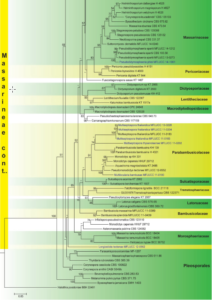Comoclathris pimpinellae Konta, Bulgakov & K.D. Hyde, sp. nov.
Index Fungorum number: IF 551949, Facesoffungi number: FoF 01769, Fig. 2
Etymology: The specific epithet refers to the host genus Pimpinella.
Holotypus: MFLU 15–0010
Saprobic on dead stems of Pimpinella tragium Vill. subsp. titanophila (Woronow) Tutin (syn. Pimpinella titanophila Woronow) appearing as black spots on host surface, or small black lines arising from cracks in the epidermal cells. Sexual morph Ascomata 155 – 135 wide × 88 – 95 μm high (x̄ = 149 × 95 μm, n = 10), solitary or aggregated, semi-immersed or rarely somewhat superficial, globose to subglobose, dark brown to black. Peridium 10 – 19μm wide, comprising an outer layer of dark brown cells of textura angularis and inner layer of mostly hyaline to pale brown cells of textura angularis. Hamathecium comprising numerous, 1.3 – 2.1 μm wide, septate, pseudoparaphyses. Asci 58 – 75 × 14 – 16 μm, (x̄ = 62 × 16 μm, n = 10), 8 – spored, bitunicate, fissitunicate, cylindrical – clavate, short-pedicellate, rounded at the apex, with indistinct, shallow, ocular chamber. Ascospores 14 – 16 × 5 – 8 μm (x̄ = 15 × 7 μm, n = 10), overlapping biseriate, yellow to light brown, transversely septate or muriform, with 3 transverse septa, central segments with 2 longitudinal septa, end segments with 2 angular septa, surrounded by a thick, hyaline, a mucilaginous sheath. Asexual morph Undetermined.
Culture characteristics: Colonies on MEA, reaching 5 – 6.5 cm diam. after 2 weeks at 16 °C, smoky – grey to dark green, margins smooth, medium dense, with fairly fluffy surface.
Material examined: RUSSIA, Rostov region, Shakhty City, near Grushevsky Pond, stony steppe, dead stems of Pimpinella tragium Vill. subsp. titanophila (Woronow) Tutin (syn. Pimpinella titanophila Woronow), 18 May 2014, T.S. Bulgakov (MFLU 15–0010, holotype, HKAS, isotype); ex-type living culture, MFLUCC 14–1159.
Notes: Comoclathris is characterised by ascomata with circular lid-like openings and applanate, reddish brown to dark reddish brown, muriform ascospores, with single longitudinal septa (Zhang et al. 2012). This genus includes 36 species names in Index Fungorum (2016) and the type species is C. lanata Clem. In this paper we introduce C. pimpinellae based on morphology and phylogeny. Maximum Likelihood analysis of combined LSU, SSU, RPB2 and TEF sequence data (Fig. 1) indicates that C. pimpinellae is closest to C. compressa with high bootstrap support (100 % ML) and groups in the Comoclathris clade, but is distinct with other species in this genus. The sexual morph of C. pimpinellae differs from C. compressa, C. lanata (type) and C. sedi in having ascomata not surrounded by radiating brown hypha (Fig. 2a–c viz Fig. 8a and Fig. 9a, d in Ariyawansa et al. 2015b), and yellow to light brown ascospores with 3 transverse septa, with central segments with 2 longitudinal septa and end segments with 2 angular septa (Fig. 2j–m viz Figs. 8g–i and 9i in Ariyawansa et al. 2015a). No Comoclathris species have been described from Pimpinella. Therefore, we introduce C. pimpinellae as a new species based on morphology, phylogeny and host association


Fig. 1 Phylogram generated from maximum likelihood analysis based on combined LSU, SSU, RPB2 and TEF sequence data of Pleosporineae and Massarineae, Pleosporales, Dothideomycetes. Maximum likelihood bootstrap support values greater than 50 % are near the nodes. The extype strains are in bold and the new isolates are in blue. The tree is rooted with Halotthia posidoniae BBH 22481.

Fig. 2 Comoclathris pimpinellae (holotype) a Appearance of ascomata on host substrate b Close up of ascomata c Section of ascoma d Peridium e Pseudoparaphyses f – i Asci j – n Ascospores. Scale bars: a = 500 μm, b = 200 μm, c = 50 μm, d – i = 20 μm, j – n = 10 μm.
